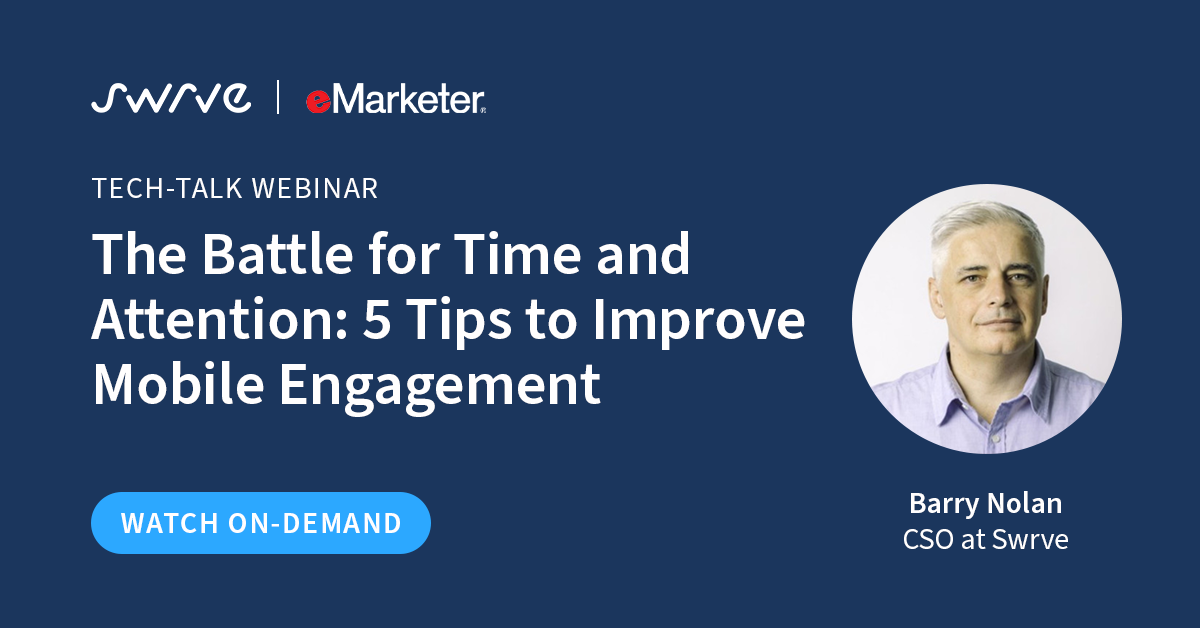Great customer experiences are essential for today’s B2C brands. And with the majority of these experiences taking place on mobile channels, success is usually judged by metrics like open rates, clickthrough rates, and conversions.
But the rules of mobile engagement have changed.
To explore the impact of this on the mobile industry, and more specifically on mobile apps, we hosted an engaging session in partnership with e-Marketer to discuss how brands can improve their mobile engagement in today’s overcrowded marketplace.
You can watch the complete on-demand webinar here or continue to read a summary of the key takeaways.
With all the noise facing consumers today, they don’t care much about what a brand has to say. They care a lot more about whether you can grab their attention, and if you can do that, you can unlock tremendous value.
Consumers spend eight out of every ten digital minutes on mobile devices. And nine out of each of those ten minutes is spent in apps.
Mobile Apps v Mobile Web
While mobile web is better for discovery, customer acquisition, and retailers with a low purchase frequency, mobile apps win at engagement, retention, conversion, and building long-term customer relationships.
Here’s why:
- Mobile app users convert 3x better than mobile web. And a lot of that is because of an easy, better experience.
- Mobile app users make 2x the purchases of mobile web users. They also spend more per purchase.
- Mobile app users abandon one-third less than mobile web users. They have an optimized app experience and are more likely to be working with repeat customers.
Shein: A Mobile-First Retailer
Shein builds their strategy around being mobile-first. They uniquely exploit the stream of first-party data. They then convert that data into insight and engagement campaigns that win the battle for attention and, ultimately, revenue and business growth.
Uniquely exploit the stream of first-party data
Privacy is the most significant disruption in retail right now, and it’s having a profound impact on third-party data and traditional ways retailers would attract and advertise to users.
For example, 88% of users opt out of app tracking which shuts down a lot of acquisition advertising. But mobile apps can help overcome this as they are a unique source of first-party intent data.
Shein changes the rules for fast fashion. They release 10,000 new products each day or rather, 10,000 experiments. They look at the browser behavior and can predict if a product will be successful or not and turn on manufacturing as and when it’s needed.
Winning the battle for attention
Mobile engagement is a combination of five elements that can be explained using a simple framework:
- Acquisition: How do new users find you?
- Activation: Is your first-time user experience optimized?
- Retention: How and why do users come back?
- Revenue: How do you make money?
- Referral: Do users tell their friends?
Shein uses this framework incredibly well. Check out the full case study in the on-demand webinar.
Improving Mobile Engagement
From analyzing retail giants like Shein along with the billions of mobile engagements across the 100s of brands we power, we have five key learnings to share.
Don’t just acquire users to grow. There is a myth in the mobile industry that you need to acquire more users to grow. However, the quickest way to succeed is to fix your onboarding.
Don’t be a pusher. There’s a myth that mobile engagement is just about push notifications. But the truth is that 96% of mobile users ignore notifications. The most important communication channel you can have in mobile engagement is in-app messaging.
Don’t maximize engagement. There is an understandable belief that the goal of mobile marketers is to maximize engagement. However, for most apps, it’s much better to minimize mobile engagement.
Don’t be shrunken email. Historically and traditionally, mobile engagement was orchestrated just like email. But the reality is that it’s much more moments-based.
Don’t treat mobile as a channel. Mobile is a continuous stream of consumer behavior. It gives you a persistent and instant connection to your customers. And in that sense, mobile is many channels.
Watch the full session recording to learn more about engaging your mobile audience.








